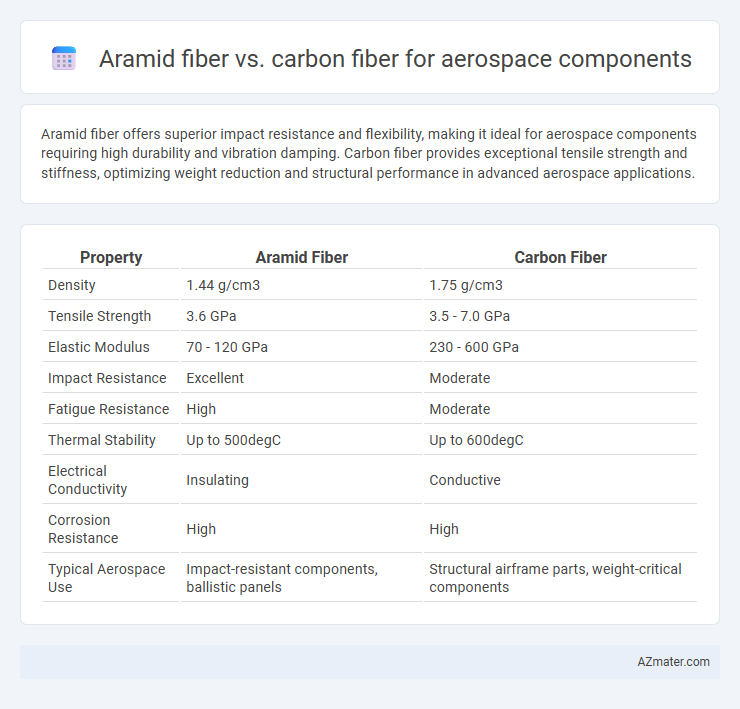Aramid fiber offers superior impact resistance and flexibility, making it ideal for aerospace components requiring high durability and vibration damping. Carbon fiber provides exceptional tensile strength and stiffness, optimizing weight reduction and structural performance in advanced aerospace applications.
Table of Comparison
| Property | Aramid Fiber | Carbon Fiber |
|---|---|---|
| Density | 1.44 g/cm3 | 1.75 g/cm3 |
| Tensile Strength | 3.6 GPa | 3.5 - 7.0 GPa |
| Elastic Modulus | 70 - 120 GPa | 230 - 600 GPa |
| Impact Resistance | Excellent | Moderate |
| Fatigue Resistance | High | Moderate |
| Thermal Stability | Up to 500degC | Up to 600degC |
| Electrical Conductivity | Insulating | Conductive |
| Corrosion Resistance | High | High |
| Typical Aerospace Use | Impact-resistant components, ballistic panels | Structural airframe parts, weight-critical components |
Introduction to Aerospace Composite Materials
Aramid fiber and carbon fiber serve as critical materials in aerospace composite manufacturing due to their high strength-to-weight ratios and exceptional durability. Carbon fiber offers superior stiffness and tensile strength, making it ideal for structural components that require minimal deformation under stress. Aramid fiber provides excellent impact resistance and energy absorption, enhancing safety in applications such as interior panels and protective gear within aerospace designs.
Overview of Aramid Fiber in Aerospace Applications
Aramid fibers, such as Kevlar, are extensively used in aerospace applications for their exceptional impact resistance, high tensile strength, and lightweight properties. These fibers provide superior energy absorption and enhanced damage tolerance in components like fuselage panels, rotor blades, and ballistic protection materials. Their excellent thermal stability and resistance to abrasion make them ideal for aerospace environments where durability and safety are critical.
Overview of Carbon Fiber in Aerospace Engineering
Carbon fiber is widely favored in aerospace engineering due to its exceptional strength-to-weight ratio, high stiffness, and resistance to fatigue and corrosion. It is commonly used in structural components such as fuselage panels, wing spars, and tail assemblies to enhance fuel efficiency and performance. The superior tensile strength and durability of carbon fiber enable the design of lightweight, high-performance aerospace parts critical to advanced aircraft and spacecraft applications.
Mechanical Properties: Aramid vs Carbon Fiber
Aramid fiber offers superior impact resistance and excellent tensile strength with low weight, making it ideal for aerospace components requiring high toughness and energy absorption. Carbon fiber exhibits higher stiffness and tensile modulus, providing exceptional rigidity and load-bearing capacity crucial for structural aerospace applications. Combining aramid's flexibility with carbon fiber's strength can optimize mechanical performance in aerospace components subjected to dynamic stresses.
Weight Considerations in Aerospace Components
Aramid fiber offers exceptional strength-to-weight ratio, making it ideal for lightweight aerospace components where impact resistance is critical. Carbon fiber provides superior stiffness and lower density, resulting in even lighter structures that improve fuel efficiency and performance in aerospace applications. Weight considerations favor carbon fiber for primary load-bearing parts, while aramid fibers are preferred for areas requiring enhanced toughness and durability.
Resistance to Impact and Fatigue
Aramid fiber exhibits superior impact resistance due to its high toughness and energy absorption capabilities, making it ideal for aerospace components subject to sudden shocks or debris impacts. Carbon fiber offers exceptional fatigue resistance with high stiffness and strength-to-weight ratio, ensuring long-term durability under cyclic loading conditions in aerospace structures. The choice between aramid and carbon fiber depends on the specific impact and fatigue performance requirements of the aerospace application.
Temperature and Environmental Durability
Aramid fiber exhibits exceptional temperature resistance up to approximately 500degC, maintaining strength and flexibility, while carbon fiber endures much higher temperatures reaching 1,500degC but can become brittle under thermal stress. Environmental durability in aerospace components favors aramid fibers for superior impact resistance and moisture absorption, whereas carbon fibers excel in withstanding chemical corrosion and UV exposure. Selecting between aramid and carbon fiber depends on balancing thermal endurance requirements and environmental exposure conditions specific to aerospace applications.
Cost Analysis and Manufacturing Differences
Aramid fiber offers lower raw material costs compared to carbon fiber, making it a cost-effective choice for aerospace components requiring impact resistance and toughness. Manufacturing with aramid fiber involves more complex handling due to its lower thermal stability, whereas carbon fiber benefits from established automation and curing processes, reducing production time and labor costs. The higher initial investment in carbon fiber is offset by its superior strength-to-weight ratio and long-term performance, critical for aerospace applications prioritizing fuel efficiency and structural integrity.
Typical Aerospace Applications for Each Fiber
Aramid fiber, known for its exceptional toughness and impact resistance, is commonly used in aerospace applications requiring ballistic protection, such as helicopter rotor blades, aircraft fuselage panels, and engine nacelles. Carbon fiber offers superior stiffness and strength-to-weight ratio, making it ideal for primary structural components like aircraft wings, fuselage frames, and satellite structures where high rigidity and weight savings are critical. Both fibers contribute to aerospace innovation by optimizing performance, with aramid fibers prioritized for durability and carbon fibers for structural efficiency.
Choosing the Right Fiber for Aerospace Performance
Aramid fiber offers exceptional impact resistance and superior toughness, making it ideal for aerospace components requiring high durability and damage tolerance. Carbon fiber provides unmatched stiffness and high strength-to-weight ratio, crucial for structural parts demanding lightweight performance and rigidity. Selecting the right fiber depends on balancing requirements for strength, weight, fatigue resistance, and impact absorption specific to aerospace applications.

Infographic: Aramid fiber vs Carbon fiber for Aerospace component
 azmater.com
azmater.com